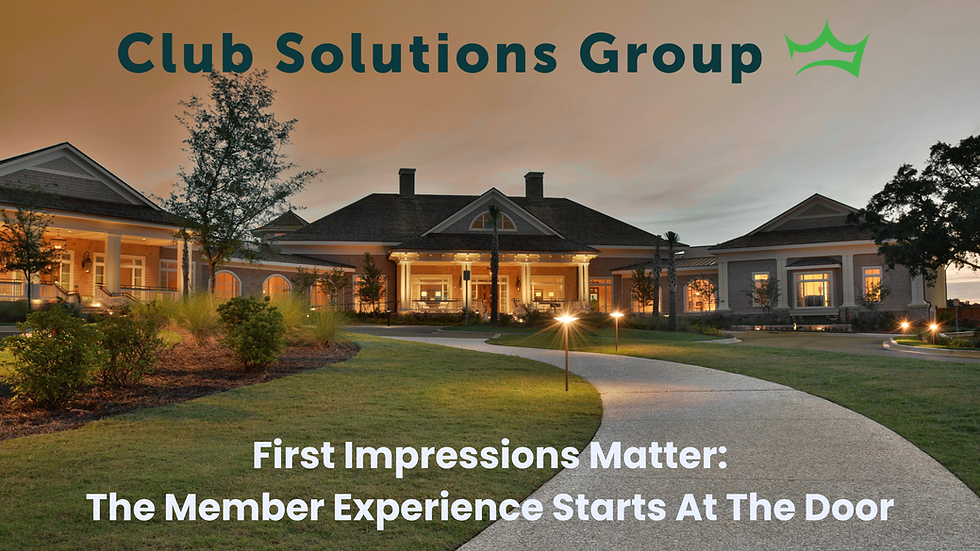Forecasting Demand and Revenue in the Country Club Industry: A Unified Data and Machine Learning Approach
- Griffin Jordan

- Nov 5
- 5 min read
Abstract
Country clubs operate across multiple service domains—golf, food and beverage (F&B), events, and retail—each with distinct demand patterns yet deeply interconnected operationally. Most clubs manage these areas through disparate systems: separate platforms for tee sheets, point-of-sale (POS), payroll, and events. This fragmentation limits their ability to anticipate demand, staff efficiently, and plan purchasing.
Club Solutions Group proposes a unified data and forecasting framework that consolidates these disconnected systems into one analytics platform and applies modern machine-learning techniques to forecast short-term and medium-term activity across F&B and golf operations.
By combining structured operational data with external variables such as:
Weather, seasonality, and local events
…the framework improves labor planning, purchasing accuracy, and revenue visibility. Building on recent studies in food service and hospitality forecasting [1][2][3], our approach emphasizes practicality and interpretability: models are evaluated not only by numerical accuracy but by their capacity to support real operational decisions that reduce costs and improve service levels.
1. Problem Statement
In the country-club business, operational success depends on how accurately managers can anticipate activity across multiple departments. Daily demand for food, beverages, golf rounds, and special events is shaped by factors like weather, seasonality, tee-sheet bookings, and member behavior.
However, the data required to forecast these patterns are scattered. POS systems record dining transactions; tee-sheet software logs rounds of golf; payroll platforms manage staff scheduling; and event calendars track banquets and weddings. Because these systems do not communicate, clubs struggle to turn their historical data into actionable forecasts.
The objective of this study is therefore twofold:
To integrate a club’s operational data into a single analytics environment that provides a comprehensive historical view of member and guest activity
To leverage this integrated dataset to develop short-term forecasts (1–30 days ahead) of covers, revenue, and golf activity, enabling proactive staffing and cost management
2. State of the Art in Demand and Revenue Forecasting
Demand forecasting in hospitality and food service has evolved rapidly over the past decade. Traditional statistical models such as ARIMA and exponential smoothing provided early baselines, but more recent studies demonstrate that Artificial Intelligence and Machine Learning algorithms—particularly gradient-boosted trees (XGBoost, LightGBM) and deep neural networks (LSTM, Temporal Fusion Transformer)—can capture complex, non-linear relationships between demand, time, and external factors [1][3][4].
The most successful models in restaurant and catering research combine historical demand data with contextual features, including:
Calendar variables — day of week, holidays, and seasonal cycles
Weather information — temperature, rainfall, wind, and humidity
Event indicators — banquets, promotions, tournaments, and private parties
Operational signals — booking counts, lead times, and reservation activity
These variables help models recognize meaningful patterns—for example, a surge in patio dining after several sunny days or a decline in F&B revenue and attendance during periods of heavy rain.
Studies across restaurants, hotels, and tourism [1][2][5] confirm that incorporating such exogenous features—external variables influencing revenue—consistently improves forecast accuracy and enhances the usefulness of predictions for real-world operational planning.

3. Accuracy and Evaluation in Practice
While academic papers often emphasize technical performance metrics such as Mean Absolute Error (MAE) or Root Mean Squared Error (RMSE), what matters most for clubs is whether the model’s forecasts are accurate enough to guide real decisions. In comparable food-service studies [2][5], models that predicted daily demand within approximately 5–10% of actual sales were considered highly successful—this level of precision was sufficient to schedule staff, order ingredients, and manage inventory effectively.
In practice, the goal is not mathematical perfection but operational reliability: forecasts that managers can trust when planning busy weekends or slower weekdays. If model predictions consistently mirror real-world trends—leading to reduced overtime, fewer shortages, and improved service levels—they can be deemed successful even if small numerical errors remain.
Accordingly, our evaluation approach balances statistical accuracy with business impact, measuring not only how closely forecasts match historical data but how effectively they enhance labor scheduling, purchasing, and the overall member experience over time.

4. How Our Approach Differs
While prior research has primarily focused on forecasting demand in restaurants, catering, or hotels [1][2][3], our work extends these methods to the country-club environment, where multiple service areas operate simultaneously and influence one another.
The distinguishing feature of our project is its ability to integrate historically disconnected data systems—including POS, tee-sheet, event scheduling, and weather—into a unified architecture that captures the complete operational picture of a club. This integrated foundation enables the development of models that forecast not only activity in the food and beverage areas, but also revenue and traffic within golf operations.
Golf rounds, tournaments, and practice-range activity exhibit strong cyclical and weather-driven patterns, which in turn drive dining and retail behavior. By modeling these dependencies, our system provides an encompassing, cross-departmental forecast that helps clubs coordinate staffing, procurement, and scheduling decisions across all departments rather than in isolation.
We are currently exploring a range of established model families popular in demand forecasting research—gradient-boosted trees, recurrent neural networks such as LSTMs, and multi-horizon architectures like the Temporal Fusion Transformer [4][5]. The objective is to develop an algorithm that adapts proven methods of demand forecasting to the private-club context, ensuring that resulting forecasts remain practical, interpretable, and directly actionable for management.
5. Methodology
The process begins with data consolidation. Each night, information from the club’s POS, tee-sheet, payroll, and event systems is ingested into a shared analytical database, alongside recent and forecasted weather data. The result is a daily record for each club venue—dining rooms, halfway houses, golf shops—containing details on sales, bookings, weather, and events.
From this foundation, the models learn familiar operational patterns: how Saturday tournaments drive lunch traffic, or how rain forecasts reduce both golf rounds and beverage sales. Every day, the system generates forecasts for the next 1 to 30 days, displaying predicted values and confidence ranges (for example, P50 as the expected value and P90 as the high-demand scenario).
These forecasts are built for action. Club managers use them to:
Add waitstaff or bartenders when high golf traffic and warm weather are expected
Reduce prep work or orders before a slower week
Shift labor between departments based on projected activity
The system is not a black box, but a decision-support tool grounded in each club’s real data and operational rhythm—helping managers turn forecasts into confident, day-to-day decisions.

6. Conclusion
Country clubs present a unique forecasting challenge because they operate as restaurants, recreational hubs, and event venues all at once. Each area follows its own rhythm of demand, yet together they shape the member experience and overall financial performance.
By integrating data across these domains and applying modern predictive techniques, we outline a pathway to decision-making that moves beyond traditional budgeting or intuition. The focus is not on statistical precision alone, but on operational impact—reducing waste, optimizing staffing, and improving revenue visibility.
Early results indicate that data integration paired with reliable, transparent forecasting can meaningfully enhance both financial performance and daily operations for private clubs. As these models continue to evolve, they offer a foundation for more proactive, evidence-based management—helping club leaders make confident decisions that improve service, efficiency, and the member experience.
References
1. [1] M. Rodrigues et al., “Machine Learning Models for Short-Term Demand Forecasting in Food Catering Services,” Journal of Cleaner Production, 2024.
2. [2] M. Aci et al., “Demand Forecasting for Food Production Using Machine Learning,” AIMS Computational Intelligence, 2025.
3. [3] H. El Madini, “Enhancing Fresh-Food Retail Forecasting with Machine Learning,” University of Copenhagen Thesis, 2024.
4. [4] B. Lim et al., “Temporal Fusion Transformers for Interpretable Multi-Horizon Time Series Forecasting,” Proceedings of NeurIPS, 2021.
5. [5] H. A. Hurtado-Mora et al., “Sales Forecasting with LSTM and Custom Loss Functions,” Applied Sciences (MDPI), 2024.
6. [6] M. C. Ruiz-Abellón, “Applications of Probabilistic Forecasting in Demand and Energy,” Applied Energy Research, 2024.



Comments